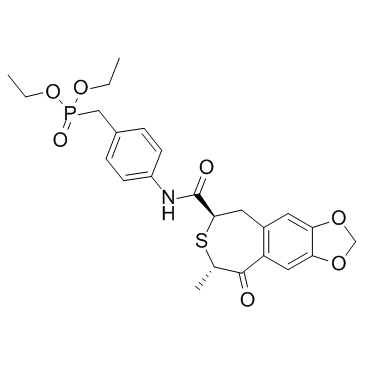| Description |
TAK-778 is a derivative of ipriflavone and has been shown to induce bone growth in in vitro and in vivo models.
|
| Related Catalog |
|
| In Vitro |
TAK-778 is a derivative of ipriflavone and has been shown to induce bone growth in in vitro and in vivo models.Continuous treatment with TAK-778 (10 μM) for 1 to 21 days results in an increase in the area of mineralized nodules. TAK-778 at concentrations of 1 μM and higher significantly stimulates the activity of cellular Alkaline phosphatase (ALP). TAK-778 increases slightly but significantly the DNA content of the cells at the confluence stage. Treatment with TAK-778 also results in dose-dependent increases in the amount of soluble collagen and osteocalcin secreted into culture medium from days 5 to 7. TAK-778 enhances the secretion of both TGF-β and IGF-I at every time point during the 21 days of culture. Treatment of the cells with TAK-778 does not induce ALP activity, but does result in a dose-dependent increase in the saturated cell density. TAK-778 at a concentration of 10 μM significantly reduces the saturated cell density[2].
|
| In Vivo |
Treatment with a single local application of TAK-778/PLGA-MC (0.2 to 5 mg/site) results in a dose-dependent increase in the radio-opaque area formed in the defect. Histological studies show the defect area is occupied by a bony bridge and the newly-formed radio-opaque area corresponds to a calcified bone containing bone marrow cavities surrounded by thick osteoid seams with cuboidal osteoblasts. There is no significant difference in either of the indices between placebo- or TAK-778/PLGA-MC-treated skulls. Two months after the operation, the TAK-778/PLGA-MC pellets induce radiological osseous union across the defects[2]. Oral treatment of OVX rats with TAK-778 causes a more pronounced increase in bone mineral density (BMD) of the lumbar vertebrae compare to vehicle controls[3].
|
| Cell Assay |
Human bone marrow cells are used and cultured in α-MEM supplemented with 10% fetal bovine serum, 50 mg/mL gentamicin, 0.3 mg/mL fungizone, 100 nM Mdexamethasone, 5 mg/L ascorbic acid, and 7 mM bglycerophosphate. Subconfluent cells in primary culture are harvested after treatment with 1 mM EDTA and 0.25% trypsin and the first passage is subcultured in 24-well culture plates at a cell density of 2×104 cells/well in culture medium containing the same volume of TAK-778 (10 μM), Tamoxifen (10 μM), and TAK-778 (10 μM)+Tamoxifen (10 μM). Cells subcultured in medium supplemented with vehicle are used as a control. During the culture period, cells are incubated at 37°C in a humidified atmosphere of 5% CO2 and 95% air, and the medium is changed every 3 or 4 days[1].
|
| Animal Admin |
Eight-week-old female Wistar-Imamichi rats are used in this study. Forty Wistar-Imamichi rats are divided into sham-operated, vehicle, TAK-778, tamoxifen, and combination (TAK-778 and tamoxifen) treatment groups. Two weeks after ovariectomy, animals are orally administered TAK-778 [100 mg/kg body weight (BW), three times per week] and/or tamoxifen (200 mg/kg BW, three times per week) for 3 months. Rats orally administered vehicle and sham operated rats serve as controls. On 13 and 3 days before killing, tetracycline (30 mg/kg BW) or calcein (5 mg/kg BW) is injected subcutaneously, and lumbar vertebrae (L2-L5) are removed for bone analysis[3].
|
| References |
[1]. Rosa AL, et al. TAK-778 enhances osteoblast differentiation of human bone marrow cells via an estrogen-receptor-dependent pathway. J Cell Biochem. 2004 Mar 1;91(4):749-55. [2]. Notoya K, et al. Enhancement of osteogenesis in vitro and in vivo by a novel osteoblast differentiation promoting compound, TAK-778. J Pharmacol Exp Ther. 1999 Sep;290(3):1054-64. [3]. Cai M, et al. TAK-778 induces osteogenesis in ovariectomized rats via an estrogen receptor-dependent pathway. J Bone Miner Metab. 2011 Mar;29(2):168-73.
|
